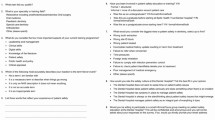Abstract
Background Dental nurses trained in assisting with relative analgesia with nitrous oxide (RA) play an important role in patient care. Provision of RA is a service provided in the Community Dental Service based in Doncaster, Barnsley and Rotherham.
Aim To explore how sedation-trained dental nurses perceive their role within a Community Dental Service, and to explore what motivates them and how they feel changes could enhance the provision of care.
Methods Twelve nurses who had experience of assisting with RA for at least one year in three community clinics in a South Yorkshire-based Community Dental Service were recruited and undertook a semi-structured interview. All interviews were transcribed verbatim and subsequent thematic analysis of the manuscripts was undertaken.
Results Five major themes were identified: 1) motivation; 2) role; 3) training and continuing professional development; 4) pressures on the service; and 5) service enhancements.
Conclusion Within this qualitative study, the dental nurses perceived that they had a crucial role in patient and parent behavioural management and keeping the patient safe during treatment. Helping patients to accept planned dental treatment gave them significant job satisfaction. Overall, this study has shown that they feel that they have a crucial role in assisting with RA treatment.
This is a preview of subscription content, access via your institution
Access options
Subscribe to this journal
Receive 24 print issues and online access
$259.00 per year
only $10.79 per issue
Buy this article
- Purchase on Springer Link
- Instant access to full article PDF
Prices may be subject to local taxes which are calculated during checkout
Similar content being viewed by others
References
Awojobi O, Movahedi S, Jones E, Gallagher J E. Can dental nurse training provide exposure to both practice and hospital settings? BDJ Team 2018; DOI: 10.1038/bdjteam.2018.102.
General Dental Council. Continuing Professional Development Requirements. 2018. Available online at https://www.gdc-uk.org/education-cpd/cpd/enhanced-cpd-scheme-2018 (accessed January 2020).
Turner S, Ross M, Ibbetson R. The impact of General Dental Council registration and continuing professional development on UK dental care professionals: (1) Dental nurses. Br Dent J 2012; 10.1038/sj.bdj.2012.664.
Awojobi O, Movahedi S, Jones E, Gallagher J E. The evaluation of an innovative dental nurse training pilot scheme. Br Dent J 2008; 224: 875-880.
General Dental Council. Scope of Practice.2013. Available at https://www.gdc-uk.org/docs/default-source/scope-of-practice/scope-of-practice.pdf?sfvrsn=8f417ca8_4 (accessed January 2020).
McNeese-Smith A. content analysis of staff nurse descriptions of job satisfaction and dissatisfaction. J Adv Nurs 1999; 29: 1332-1341.
Morison S, Marley J, Machniewski S. Educating the dental team: exploring perceptions of roles and identities. Br Dent J 2011; 211: 477-483.
Durkan C, Belsi A, Johnson R, Gallagher J E. Career choice, pathways and continuing professional development of dental nurses at one institution. Br Dent J 2012; 10.1038/sj.bdj.2012.663.
Blain K M, Hill F J. The use of inhalation sedation and local anaesthesia as an alternative to general anaesthesia for dental extractions in children. Br Dent J 1998; 184: 608-611.
Department of Health, Standing Dental Advisory Committee. Conscious sedation in the provision of dental care: report of an expert group on sedation for dentistry. 2003. Available at https://www.rqia.org.uk/RQIA/files/bc/bcb0650d-8660-4d5f-940f-ea3b60ecf5f6.pdf (accessed July 2020).
The Royal College of Surgeons of England, The Royal College of Surgeons of Edinburgh, The Royal College of Physicians and Surgeons of Glasgow, and Royal College of Anaesthetists. Standards for conscious sedation in dentistry: alternative techniques. 2007.Available online at https://www.rcseng.ac.uk/dental-faculties/fds/publications-guidelines/standards-for-conscious-sedation-in-the-provision-of-dental-care-and-accreditation/ (accessed July 2020).
Woolley S, Hingston E, Shah J, Chadwick B. Paediatric conscious sedation: views and experience of specialists in paediatric dentistry. Br Dent J 2009; DOI: 10.1038/sj.bdj.2009.664.
General Dental Council. The First Five Years: A Framework for Undergraduate Dental Education. 2nd ed. London: General Dental Council, 2002.
Day P F, Power A M, Hibbert S A, Paterson S A. Effectiveness of oral midazolam for paediatric dental care: a retrospective study in two specialist centres. Eur Arch Paediatr Dent 2006; 7: 228-235.
Mikhael M, Wray S, Robb N. Intravenous conscious sedation in children for outpatient dentistry. Br Dent J 2007; 203: 323-331.
Souto P, Robb N. Does relative analgesia with nitrous oxide reduce the number of general anaesthetic sessions and dental loss? Br Dent J 2018; 224: 429-433.
Stewart K, Gill P, Chadwick B, Treasure E. Qualitative research in dentistry. Br Dent J 2008; 204: 235-239.
UK Government Ministry of Housing, Communities & Local Government. English indices of deprivation 2019. 2019. Available online at https://www.gov.uk/government/statistics/english-indices-of-deprivation-2019 (accessed January 2020).
Peat G, Rodriguez A, Smith J. Interpretive phenomenological analysis applied to healthcare research. Evid Based Nurs 2019; 22: 7-9.
The Royal College of Surgeons of England, The Royal College of Surgeons of Edinburgh, The Royal College of Physicians and Surgeons of Glasgow, and Royal College of Anaesthetists. Standards for Conscious Sedation in the provision of Dental Care and Accreditation. 2015. Available online at https://www.rcseng.ac.uk/dental-faculties/fds/publications-guidelines/standards-for-conscious-sedation-in-the-provision-of-dental-care-and-accreditation/ (accessed January 2020).
Lave J, Wenger E. Situated Learning: Legitimate Peripheral Participation. New York: Cambridge University Press, 1991.
Acknowledgements
We would like to thank the participants for taking the time to take part in our study. We would also like to thank the dental nurse managers of the service for their support in recruiting participants.
Author information
Authors and Affiliations
Corresponding author
Rights and permissions
About this article
Cite this article
Radford, P., McKay, A. The self-perceived role of sedation-trained dental nurses within a Community Dental Service: a qualitative study. Br Dent J (2020). https://doi.org/10.1038/s41415-020-1927-6
Published:
DOI: https://doi.org/10.1038/s41415-020-1927-6



